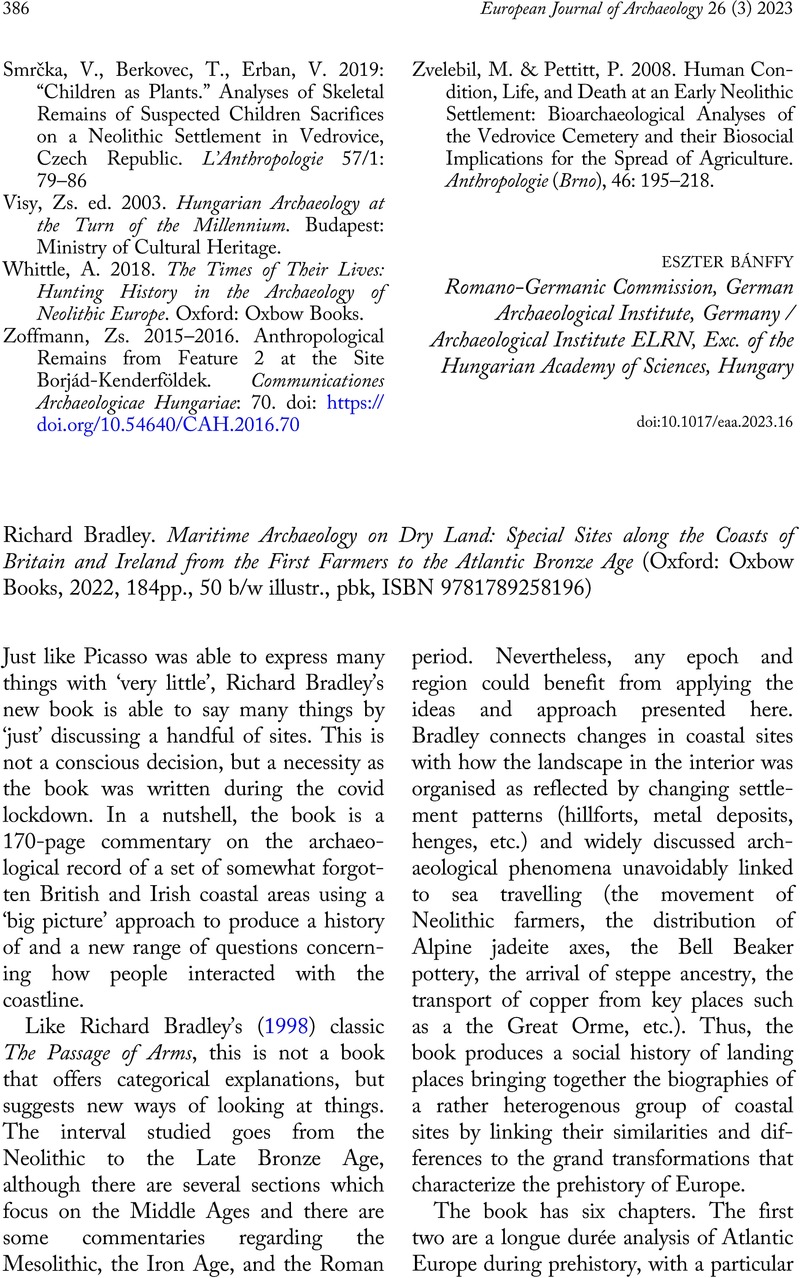No CrossRef data available.
Article contents
Richard Bradley. Maritime Archaeology on Dry Land: Special Sites along the Coasts of Britain and Ireland from the First Farmers to the Atlantic Bronze Age (Oxford: Oxbow Books, 2022, 184pp., 50 b/w illustr., pbk, ISBN 9781789258196)
Review products
Richard Bradley. Maritime Archaeology on Dry Land: Special Sites along the Coasts of Britain and Ireland from the First Farmers to the Atlantic Bronze Age (Oxford: Oxbow Books, 2022, 184pp., 50 b/w illustr., pbk, ISBN 9781789258196)
Published online by Cambridge University Press: 13 July 2023
Abstract
An abstract is not available for this content so a preview has been provided. Please use the Get access link above for information on how to access this content.

- Type
- Book Review
- Information
- Copyright
- Copyright © The Author(s), 2023. Published by Cambridge University Press on behalf of the European Association of Archaeologists
References
Bradley, R. 1998. The Passage of Arms: An Archaeological Analysis of Prehistoric Hoards and Votive Deposits (2nd ed.). Oxford: Oxbow Books.Google Scholar
Bradley, R., Rogers, A., Sturt, F., Watson, A., Coles, D., Gardiner, J. & Scott, R. 2016. Maritime Havens in Earlier Prehistoric Britain. Proceedings of the Prehistoric Society, 82: 125–59. doi: https://doi.org/10.1017/ppr.2015.22CrossRefGoogle Scholar
Bradley, R., Watson, A. & Scott, R. 2017. The Earlier Prehistoric Collections from the Culbin Sands, Northern Scotland: the Construction of a Narrative. In: Hurt, F. & Sheridan, A., eds. Ancient Lives: Object, People, and Place in Early Scotland. Essays for David V Clarke on his 70th birthday. Leiden: Sidestone Press, pp. 233–43Google Scholar
Bradley, R., Watson, A., Scott, R., & Jack, A. 2017. Littleferry, Sutherland: An Earlier Prehistoric Coastal Site in Context. Proceedings of the Society of Antiquaries of Scotland, 147: 17–28. https://doi.org/10.9750/PSAS.147.1248CrossRefGoogle Scholar
Carreras, C., & Morais, R. 2012. The Atlantic Roman Trade During the Principate: New Evidence from the Western Façade. Oxford Journal of Archaeology 31(4): 419–441. https://doi.org/10.1111/j.1468-0092.2012.00396.xCrossRefGoogle Scholar
Clark, P. 2005. Shipwrights, Sailors and Society in the Middle Bronze Age of NW Europe. Journal of Wetland Archaeology 5(1): 87–96. doi: https://doi.org/10.1179/jwa.2005.5.1.87CrossRefGoogle Scholar
Cunliffe, B. 1990. Hegistbury Head: A Late Prehistoric Haven. In: McGrail, S., ed. Maritime Celts, Frisians, and Saxons: Papers Presented to a Conference at Oxford in November 1988 (Council for British Archaeology Research Report 71). London: Council for British Archaeology, pp. 27–31.Google Scholar
Cunliffe, B. 2017. On the Ocean: The Mediterranean and the Atlantic from Prehistory to ad 1500. London: Oxford University Press.Google Scholar
McGrail, S. 1981. The Brigg ‘Raft’ and Her Prehistoric Environment. Oxford: British Archaeological Reports.Google Scholar
McGrail, S. 1993. Prehistoric Seafaring in the Channel. In: Scarre, C. & Healy, F., eds. Trade and Exchange in Prehistoric Europe: Proceedings of a Conference Held at the University of Bristol, April 1992. Oxford: Oxbow Books, pp. 199–211.Google Scholar
Parfitt, K. 2004. A Search for the Prehistoric Harbours of Kent. In: Clark, P., ed. The Dover Bronze Age Boat in Context: Society and Water Transport in Prehistoric Europe. Oxford: Oxbow Books, pp. 99–105.Google Scholar
Van de Noort, R. 2006. Argonauts of the North Sea: A Social Maritime Archaeology for the 2nd Millennium bc. Proceedings of the Prehistoric Society, 72: 267–87. doi: https://doi.org/10.1017/S0079497X00000852CrossRefGoogle Scholar


